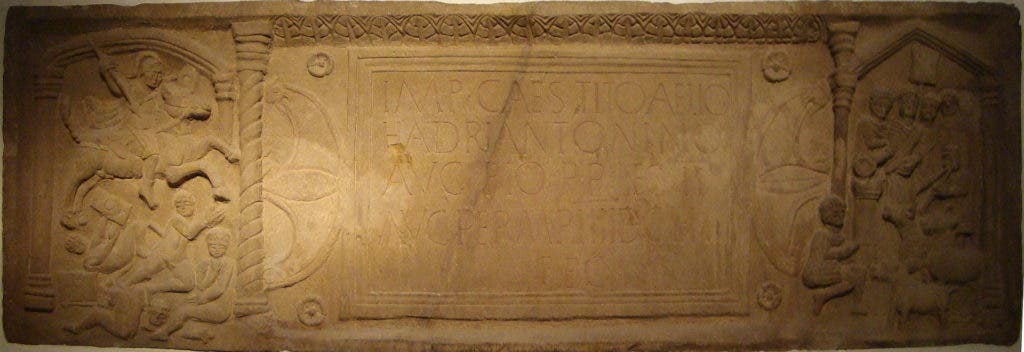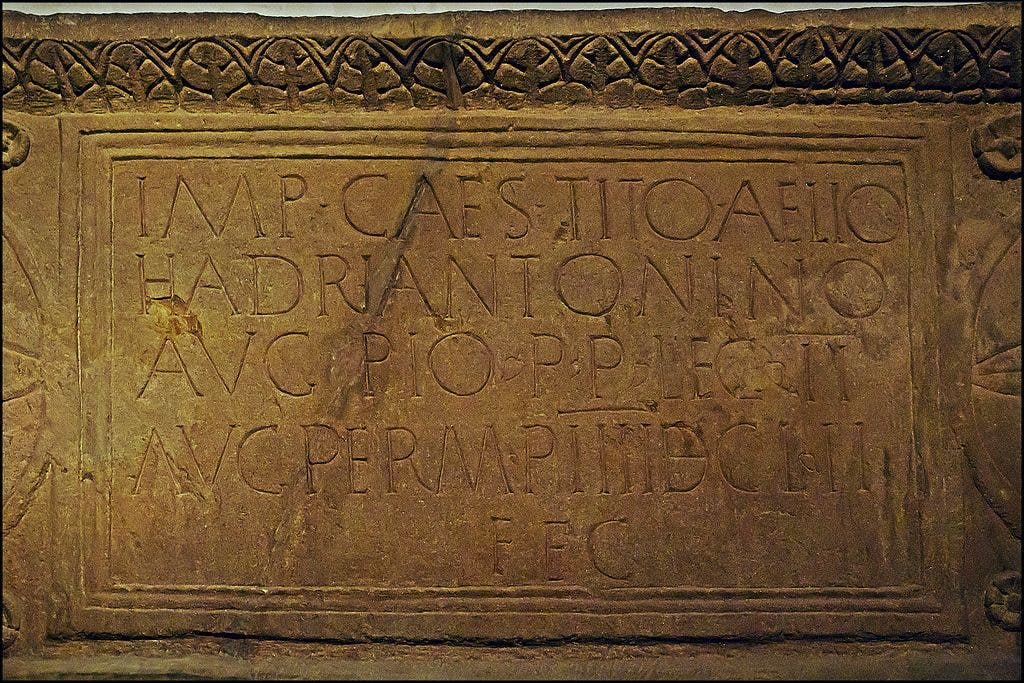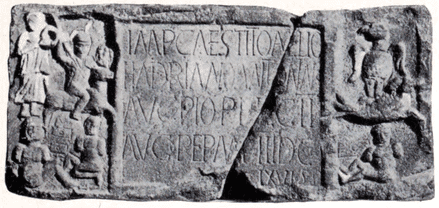Ancient Romans didn’t have any qualms about using some propaganda to keep Scottish tribes in line (and far away).

The original Bridgeness Slab, currently at the National Museum of Scotland, Edinburgh.
Image via Wikimedia / user Barnimg.
What’s the best way to keep roving, rampaging Scottish tribesmen from pillaging your forum? To be honest, it’s probably a heavily-armed legion — but dazzling red, yellow, and white paints come a close second, according to Louisa Campbell, an archaeologist at the University of Glasgow.
A great, big, physical, painted wall
Known as the Antonine Wall, the fortification was built in the mid-second century AD right on the edge of Rome’s holdings in England. Like The Wall in Game of Thrones — for which it likely served as inspiration — the Antonine Wall was meant to keep dangerous northerners away. To make sure it worked, the Romans made sure this wall was scary — stone slabs placed along the wall were adorned with bloody-beaked Roman eagles, and images of victorious legionnaires with decapitated enemies. Just for good measure, the stones also sported carved-in Latin inscriptions alongside these graphic warnings.

The inscription on the Bridgeness slab is a dedication to the Emperor Antoninus Pius. It reads (often with abbreviations):
Emperor Caesar Titus Aelius / Hadrianus Antoninus / Augustus Pius, Father of his Country, The Second Legion / Augusta, made (built) four thousand six-hundred and fifty-two paces (of the wall).
Image via Wikimedia / user dun_deagh.
According to Louisa Campbell, an archaeologist at the University of Glasgow, the stone slabs were “Roman propaganda” used to scare off local tribespeople living north of the Antonine Wall (basically, today’s Scotland). The stones are now their natural plain grey, but Campbell’s research shows they were once painted in bright colors. She reports finding residues of natural red and yellow ochre pigments, of matter and realgar (a plant used to make red dye and a red mineral respectively), white lead, and orpiment (a bright yellow mineral).
Campbell studied 19 such slabs (or “distance stones”) found along the wall, including the two most famous of these stones: the Summerston and the Bridgeness Slab. Both depicted scenes of Roman cavalry mowing through northern warriors or guarding bound captives. The Bridgeness Slab also showed a decapitated warrior in the midst of a battle, and Campbell found residue of red paint on both ends of the severed neck. The Summerston Slab might have featured a blood-red painted Roman eagle.
Red seems to have been primarily used to paint details, such as the cloaks of Roman soldiers and spatters of blood on the enemies of said soldiers. It seems to me like a subtle, quite smart use of the color. On one hand, it makes the legionnaires clearly distinguishable, capitalizing on Rome’s iconic red uniforms. On the other hand, it made it clear that invaders would be met with a bloodbath. Perhaps less immediately apparent, but no less intimidating, is that the only red on the legionnaires was on the cloaks — ‘Rome will defeat you’, this symbolizes, ‘and you won’t even be able to scratch our soldiers’.
These propaganda stones were placed at intervals along the Antonine Wall to mark Roman superiority in the region, and discourage any thoughts of invasion. It’s also possible that the stones were as much a show of force for Roman subjects as they for invaders, there to make the people feel safe and keep them content.
Modern advertisers would probably applaud the design ideas behind these slabs.
“I would suggest the red on the beak of the eagle (the symbol of Rome and her legions) symbolizes Rome feasting off the flesh of her enemies,” Campbell wrote in an email for Live Science.
Rome didn’t hang on to the wall for very long, despite its propaganda efforts; maybe northern warriors thought the legions were overcompensating? Whatever the case, the Antonine Wall (whose construction was commissioned in 142 A.D.) was abandoned sometime in 161 A.D. for unknown reasons. The Empire briefly re-captured it between 208 to 211 A.D., but they never succeeded in establishing the wall as Rome’s permanent northernmost border.
“The public are accustomed to seeing these sculptures in bland greys, creams, white (for marble) and don’t get the full impact that they would have had on the Roman and indigenous audiences 2,000 years ago,” Campbell told the Bailiwick Express.
“Knowing how colour was used by the Romans to tell stories and create impact is a huge leap forward in understanding these sculptures,” added Patricia Weeks, Antonine Wall coordinator at Historic Environment Scotland.
Long stretches of the wall’s stone ruins are still visible today, although the earth-and-wood sections haven’t fared as well.










